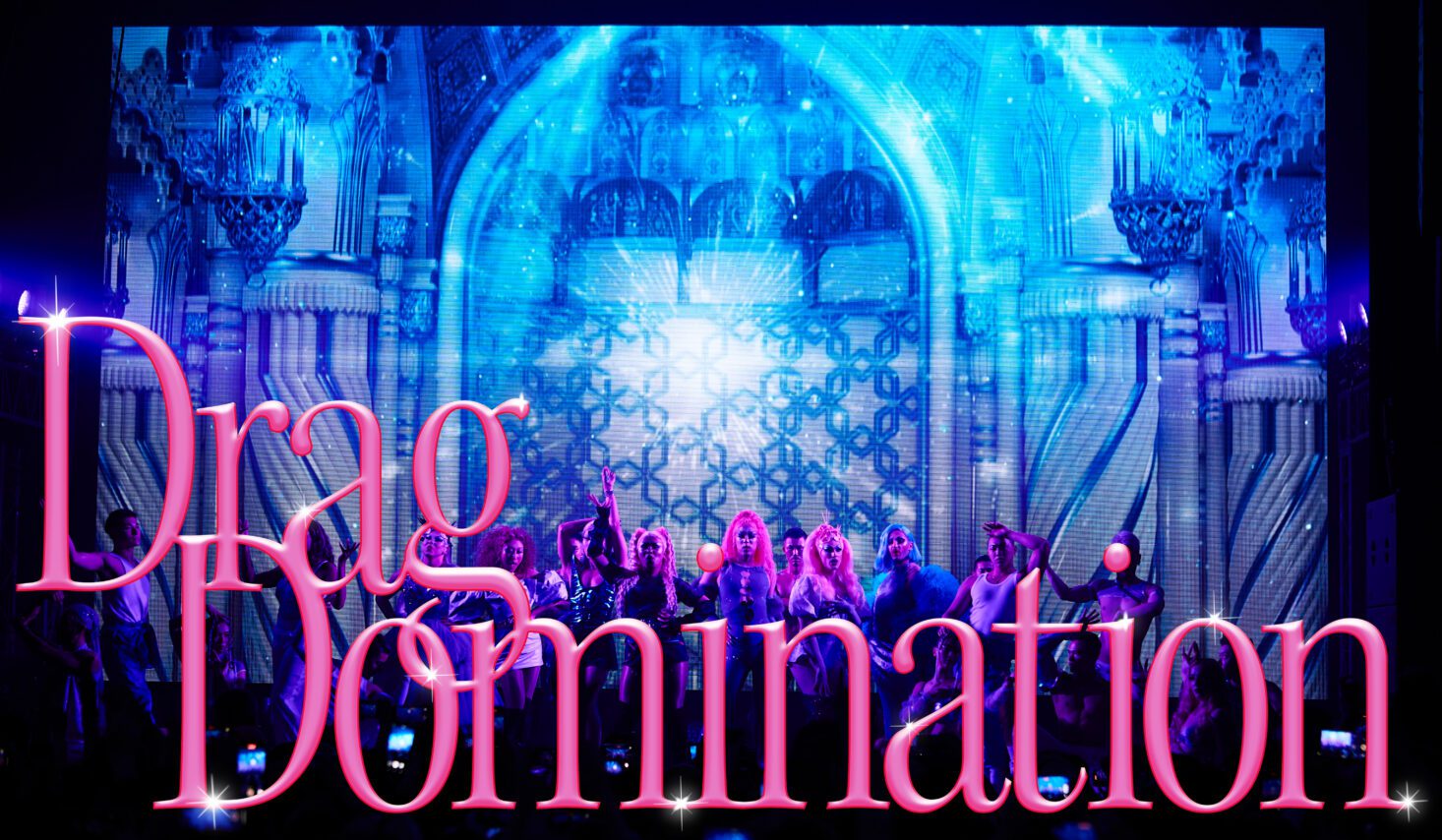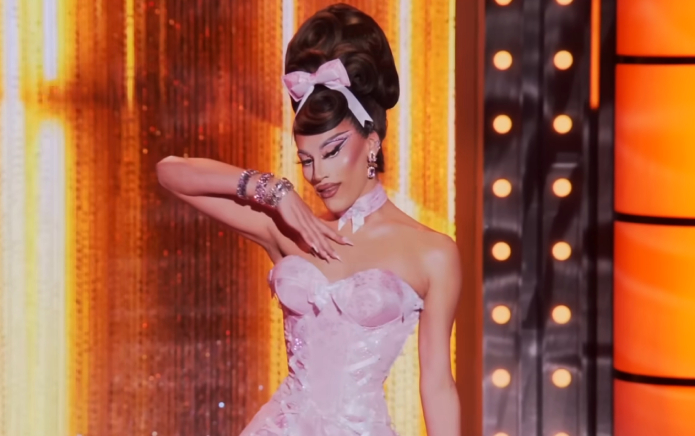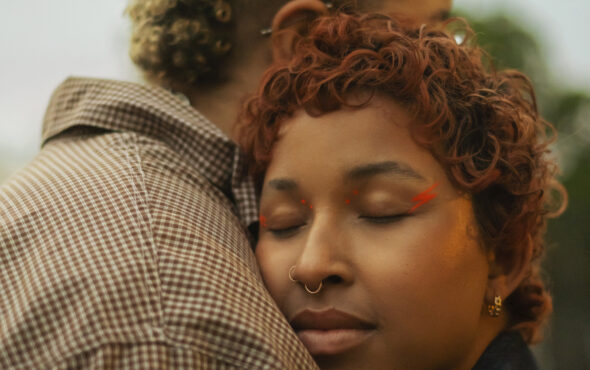
The mood backstage of Opulence is frantic, fluorescent and a friendly frenzy. I’m slithering about the common dressing room the local queens and backup dancers share, trying to keep out of everyone’s way. I have my press pass in my purse, though since I’m in drag no security guards question my presence.
Out in the hall, I can see the doors labelled “Raja,” “Pangina,” “Denali.” I lock eyes with friends in the dressing room mirror, and we exchange nervous grins. I’m anxious because I’ll be interviewing the Ru girls soon. They’re anxious because they’ll be performing in front of a room of 1500. “I have terrible news, everyone,” says Philippine-born co-organiser and performer Vera Strondh. She smiles. “We have one hour til doors.”
In the past year, Japan’s drag community seems to have grown in leaps and bounds. Every week I hear of new drag shows, new hostess bars, new drag go-go events. After the country’s long period of curfews and closed borders during the COVID pandemic, the return of these lively nights in Shinjuku Ni-chōme (Tokyo’s largest Gay Town) is a joy and a relief.
May’s Opulence event, the international drag show spearheaded by Strondh and her colleague, UK-born Tom Hall (also known as drag queen Gyoza Tonin-Anang), in collaboration with Sony, heralds a new era for Tokyo drag: bigger shows, bigger budgets, and celebrity guest performers. Last week’s Opulence Vol. 2 saw Strondh and four other local queens eagerly take to the stage alongside RuPaul’s Drag Race stars Raja Gemini, Pangina Heals, and Denali Foxx. It was the country’s largest locally-organised international drag show to date.
The increased global attention on the drag scene of Tokyo (and beyond it, Japan) brings with it both excitement and anxiety among the local queens. Will there be a Drag Race Japan spinoff show, much rumoured? Will there be space for weird and avant-garde drag in the new, pop media-dominated world? And perhaps most importantly, what will it mean for those queens who do ‘make it big’ on the international stage, and find themselves asked to represent a country’s entire queer community?
As an active Tokyo drag queen myself for the last four years, I reached out to my friends and colleagues from across the community to discuss the recent changes in the scene, and their hopes and fears for the future.
Japan’s Drag History
Japan has a long, rich history of cross-gender performance and private cross-dressing, predating both drag and, indeed, the concept of queer or gay identities. One of the earliest examples of what might be considered proto-drag dates to the middle Edo Period, where tekomai (drag king-like female festival dancers) would perform throughout the city and pump the crowd during religious holidays.
As covered extensively in the works of Mark McLelland and Katsuhiko Suganuma, modern Japanese drag developed chronologically following the eras of danshō (female-presenting sex workers of the post-war decade) and the gei bōi movement of the 1950s onward. Gei bōis were an umbrella subculture referring, generally, to effeminate queer men involved in Japan’s LGBTQ+ nightlife as lounge singers, cabaret performers, and hosts/hostesses. In actuality, these popular and stylish entertainers might, from today’s standpoint, range from gay men, to third gender, to transgender women.
Many of Japan’s earliest generations of drag queens, such as Akihiro Miwa who debuted as a nightclub singer in 1952, can trace their origins to the gei bōi subculture.
The word “drag queen” entered the Japanese lexicon around the early 1980s, and with it came the first self-described drag queens of Japan, including celebrated Simone Fukayuki, co-founder and current organiser of the long-running Kyoto drag show, Diamonds Are Forever. The next three decades saw a great deal of diversity and experimentation among the successive waves of drag queens, many of whom were influenced by the Club Kids of New York and by counter-cultural films such as ‘Rocky Horror’, ‘Priscilla, Queen of the Desert’, and ‘Hedwig’.
As Tokyo-native and Opulence cast member Sasha B. Savannah points out, different regions such as Nagoya, Osaka, Kyoto, and Tokyo have distinct cultures of drag. In addition to this, one of my own observations has been that earlier waves of Japanese drag queens tend to focus more on camp, comedy, and bar hostessing—indeed, much of the brick-and-mortar community of Shinjuku Ni-chōme has been built thanks to the drag mamas and the bars they protect.
Growing Pains A.D.R.
Major drag icon Durian Lollobrigida once joked we were living in the era A.D.R. — ‘After Drag Race’ – a term my friends and I have used ever since.
This is the year 13 A.D.R., roughly thirteen years after RuPaul’s Drag Race took off as a global phenomenon and brought a major shift to the world’s drag communities. Japan was similarly impacted, in ways both good and bad. One major shift was how the broader queer community saw drag queens; suddenly it was cool and trendy in one’s femme side.
Australian-born Belgium Solanas is perhaps the longest-performing foreign drag queen in Japan, after debuting in 2009 in Osaka and continuing to perform across Kansai, Nagoya, and Tokyo.
Reminiscing on her career in avant-garde artistry, Solanas explains: “I don’t know how many [younger queens] realise how different it was before [Drag Race] gradually gave everyone permission to do drag as a form of expression without the negativity and even danger it used to be associated with. Drag queens were social pariahs, and gender roles were much more rigid. That’s partly why people were so confused and interested in my work. Obviously, we had a lot of love and support early on too.”
Tokyo queen Savannah, who has performed her Beyonce impersonations for thirteen years now, agrees. “It’s much less common now,” she says, “but in the past, there were times when people were verbally abusive or wouldn’t talk to you in the first place. There are still times when straight men try to forcibly kiss you just for an amusing story, or call you slurs like ‘okama.’”
One benefit of the popularisation of drag in mainstream culture is that some of these dangers and prejudices have eased, at least within Japan’s queer community. Younger drag queens and drag experimenters are often welcomed with open arms within Ni-chōme these days. On the flip side, artists like Solanas sometimes feel squeezed out by the trendier dancing queens, and feel most Drag Race fans forget that there are many types of drag beyond what they see on reality television. In addition, Solanas feels alienated by the intense and rapid commercialization of the art.
Kyoto queen Fukayuki expresses a similar reservation, urging drag participants and viewers to find and appreciate the countercultural and underground drag cultures of Japan as well.
Other growing pains the drag scene has experienced involve tensions between different generations and ethnic backgrounds, as one might expect from a community spanning a diverse crowd of ages, ethnicities, and nationalities. Japanese-Brazilian drag queen Labianna Joroe, who served as MC at May’s instalment of Opulence, notes that even with her successful drag career, she has heard other queens make discriminatory jokes about race, and has felt both tokenized in some cases and passed over for bookings in others.
French-born Laotian drag queen Kosmic Sans, who performed at the first Opulence, further attested to the discrimination Joroe experienced. “Some old-school queens tend to target the new wave / new generation of drag, describing it as a foreign pandemic or invasion,” she says, referring to the Drag Race influence. She further adds that dialogue with the older Japanese queens is sometimes difficult. “There also was this trend of ‘African beauty makeup’ that was basically black face. Some of those queens refused to face the conversation. Luckily the whole scene is not that closed-minded.”
In spite of these tensions, the vast majority of the community that I’ve experienced is positive and tight-knit, if sometimes guarded against newcomers. These past four years, I’ve been especially pleased to see the Japanese and foreign queens forming stronger ties and organising more mixed drag shows.
OPULENCE VOLUME2
本日(4/7)10:00~一般販売開始!
一番人気のミーグリ付きも多少ございます!e-plushttps://t.co/mjT3Mryhww
Zaiko(English support and ticket sales)https://t.co/uzsLYL2BJT pic.twitter.com/MtXK6ZEUrp
— DRAGMANIA/OPULENCE (@dragmaniajp) April 6, 2023
A Working Queen
One of the greatest benefits many queens look forward to as Japan’s drag scene grows is the potential for more bookings and more stable careers. Indeed, as I ask my colleagues whether they found drag in Japan profitable, we suppress snickers. “If you’re not working for a straight-owned company or television, no!” Joroe exclaims. “The performance art is very under-appreciated in Japan if it’s not a huge production… most queens have a day job or work at bars as hostesses to guarantee their check.”
“Even big gigs won’t cover the cost of your outfit and makeup—and I’m not even including preparation time, dancers, help, and studio space,” Sans adds. Savannah is one of the rare queens who managed to transition to a full-time career as a showgirl roughly five years ago. “Until then, it was hard to make a steady income and I didn’t have regular opportunities,” she says. “In the last few years, some clubs and bars have opened up that hire drag queens every day. The demand has increased.”
While the hyper-commercialization of any art through franchising is a leery topic, most agree that a larger and more lively scene will lead to improvements in their lives. Many hope that steadily building their name recognition and social media stardom will provide them with the booking fees they need to devote themselves to drag. For a few, competing in one of the Drag Race shows may be one means to achieve that pull.
The Future of the Queens
Contemplating the future of Japan’s drag scene, I feel much like the queens backstage of Opulence that evening — a great deal of excitement mixed with nervousness. I worry, of course, like Solanas, that an alternative and AFAB (assigned female at birth) queen like myself will be pushed out if drag veers too far into the mainstream.
But I’m also looking forward to a post-COVID Japan where I can have many more days like this one to come. More rushing around backstage, more interviews with drag queen legends I could never have dreamt of meeting before, more chaos and last-minute disasters and repairs. For me, drag has always been about belonging to a circle and to a found family more than occupying the spotlight. Slinking into the large, shared dressing room and getting a faceful of glitter from one of the backup dancers gives me that feeling. Walking through Pride and stepping on a friend every three metres gives me that feeling. And of course, free drink tickets always make me feel welcome.
Most of all though, I want more chances to see my friends and fellow drag queens here in Japan thrive, those talented and ambitious people who can set a room of 1500 on fire with a glance. A world where they’re on top is a world I want to be in, and I can’t wait to see what’s coming next.



